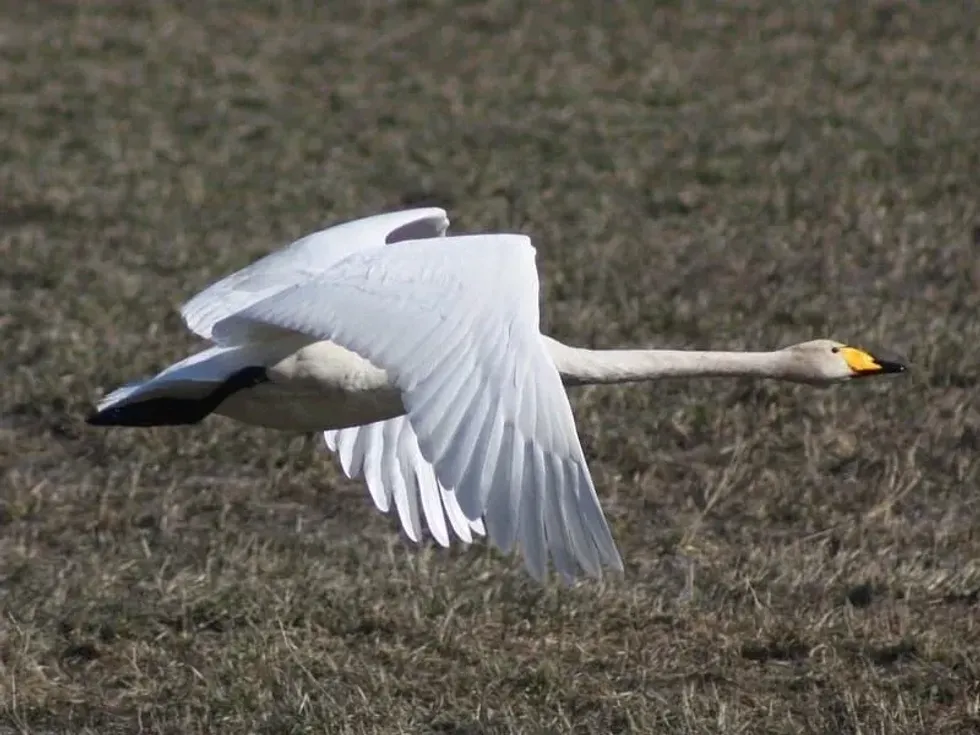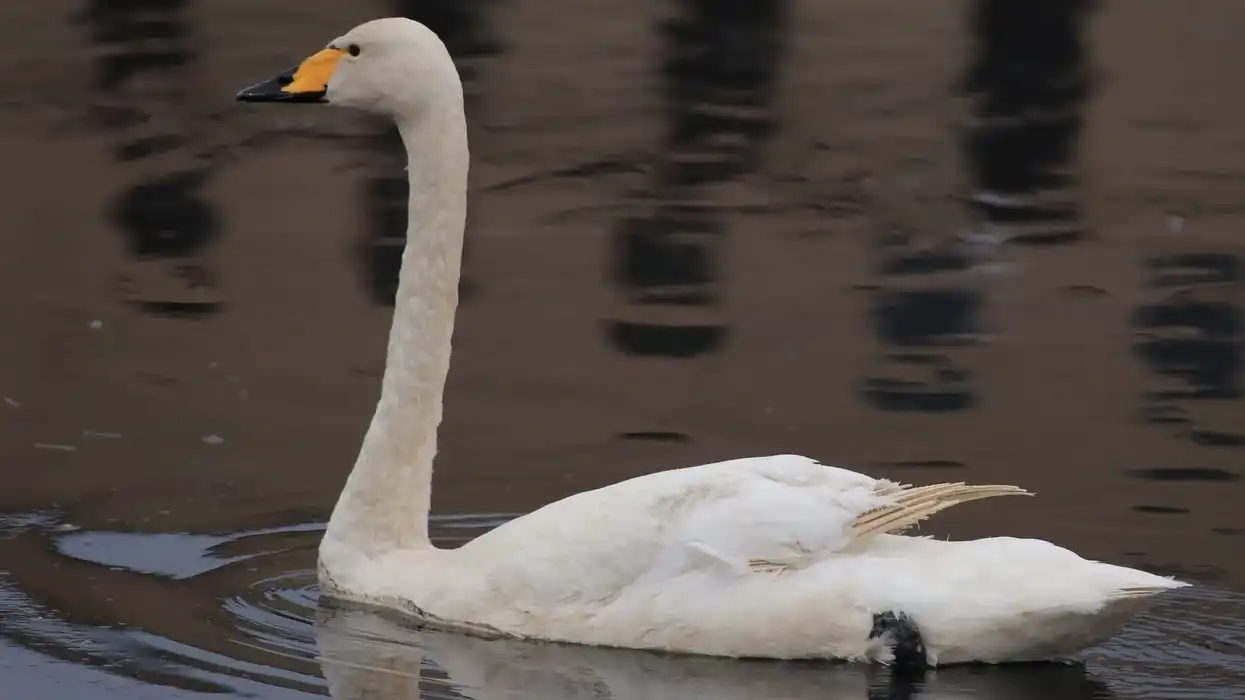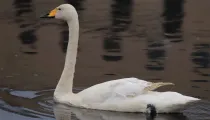Fun Whooper Swan Facts For Kids

The whooper swan, Cygnus cygnus, is called by the name common swan too. Its pronunciation is ‘hooper swan’. It is a large swan species belonging to the northern hemisphere. It specifically belongs to Eurasia or the Europe-Asia part and is considered the counterpart of the North American swan which is also known as the Trumpeter swan.
The migratory counterparts of whooper swans are found in India and North America. The trumpeter swan of North America is also of the genus Cygnus. Cygnus is the Latin word for swan.
The whooper swan belongs to the family of Anatidae. The family of Anatidae consists of ducks geese and swans. The whooper swan is a large migratory bird and is considered to be one of the most aesthetic swans in the family. The name whooping refers to the loud whooping sounds it makes.
Earlier this swan was called an elk swan. The whooper swans come to the UK in winter. They migrate southwards in the winter. They return to the northern parts in the spring.
The whooper swan has a long neck and a yellow bill. It makes loud trumpet-like calls which also differentiates it from the mute swan.
The whooper swan nests in a variety of swamps and water systems. The breeding area of this species is Iceland, Russia, and Scandinavia which belong to the northernmost parts of the northern hemisphere. Their breeding season begins in late April.
In winter whooper swan spends most of its time near lakes, lagoons, marshes, and similar aquatic areas. The whooper swan can be seen in Europe from October to March. After March they have their breeding season.
Their lifespan varies from 9-26 years. They feed on a lot of vegetation.
A common cause of their death is when they feed on agricultural cereals instead of migrating to the southern parts to feed on aquatic plants. The whooper swan is listed as of Least Concern by the IUCN in their Red List.
They are threatened by habitat destruction and animals and hence this status might change in the near future if not controlled.
You may also check out swan facts and swan goose facts from Kidadl.
Whooper Swan Interesting Facts
What type of animal is a whooper swan?
The whooper swan, Cygnus cygnus, is a type of bird.
What class of animal does a whooper swan belong to?
Whooper swans belong to the class of Aves (birds).
How many whooper swans are there in the world?
The global whooper swan population is above 180,000, as per recent studies.
Where does a whooper swan live?
Whooper swans live in wetlands and marshes with the availability of water bodies like lakes and ponds. Their populations are also found in taiga vegetation and polar regions. It is common to see swans along the west coast of Norway.
What is a whooper swan's habitat?
Whooper swan populations are known to breed and set up their nests in aquatic areas, i.e. alongside pools, shallow rivers, freshwater lakes, swamps, and marshes.
They feed in shallow regions of aquatic areas. They find it more preferable to live near emergent vegetation and to choose these shallow areas for their habitat. The vegetation provides protection for their newborn cygnets and their nests.
In Iceland, they are found in habitats that range from sea level to elevations of up to 3,000 ft (700 m). The non-breeder populations are found in near lagoons, estuaries, and shallow bays.
Migrating whooper swans can be seen flying at altitudes of up to 5,500 ft (1700 m) when crossing the oceans. But, generally, they prefer flying at lower levels which facilitates them in taking breaks between their journeys and feeding on food.
Non-breeders are found generally in flocks along sheltered coasts.
In winter whooper swan population spends its time on marshes, floodplains, lagoons, coastal bays, and freshwater lakes. They are nowadays using wet pastures and low-lying coastal agricultural lands too.
Who does the whooper swan live with?
Whooper swans live in separate pairs in the breeding season (summer, which begins by late April) but become social in the winter when they live in flocks. In winter whooper swan flocks can include up to 40 birds.
How long does a whooper swan live?
Whooper swans can have varying lifespans which can range between 9-25 years.
How do they reproduce?
Whooper swans are monogamous birds, meaning that the adults mate for life. They might find new mates if the previous adult mate in the pair dies. These adult swans can be territorial and aggressive in the breeding season, and beat their wings violently.
The pairs breed once annually. The adult whooper swan breeding season occurs mostly in the summer months of April and May.
The male and female adult whooper swans greet each other with a graceful neck and head bobbing, bowing, and rubbing against each other. The pairs also use gentle wing flapping to show affection. After mating, many pairs preen each other.
The whooper swan pairs are spotted outside from October to March after which they proceed for breeding.
Their breeding season begins in late April. Most eggs are laid between late April and May. Whooper swans are solitary nesting birds. They make nests on large mounds of dead plants, moss, and lichen. Nests are built along with the territory of the water body, on islands or shores.
The female whooper swan parents lay around four to seven eggs and incubate them for 30-40 days. The male whooper swans guard the eggs and nest territory against predators and other swans, though they do not participate in incubation.
It is essential for the parents to protect the eggs at this time because the eggs are increasingly vulnerable to predators.
The baby swans or cygnets are born after incubation. Cygnets are precocial and leave the nest early. In 70-90 days, the cygnets are able to fly.
Cygnets need their parents the entire winter. However, young juvenile swans, despite becoming independent in a year, sexually mature at the age of four. Till that time they can stay with the parent swan pairs, and form a family of two parents and their young ones of one or two years.
What is their conservation status?
The whooper swan species population is said to be of Least Concern by the IUCN Red List. The swan whooper species population distribution has a big threat from habitat destruction and loss.
Agricultural expansion is another contentious issue that may trouble the whooper swan. The species population suffers a lot from the hazardous oil spills and from various oil explorations. Their population is also threatened by hunting, nest destructions, and constant eggs collection or poaching.
They are also susceptible to poisoning from lead shot ingestions. They are troubled by natural disasters such as snowstorms or droughts. They may also suffer from Avian Influenza and are threatened from outbreaks of this disease in the future.
Conservation efforts have been started to preserve and protect the wetland sites from China to Iceland. There are laws to make swan hunting illegal in Russia.
Whooper Swan Fun Facts
What does a whooper swan look like?

The whooper swan has white plumage and black webbed feet. These webbed feet are the characteristic body feature in the family of swans. Their bills are yellow with black tips. Their beak markings can be a distinguishing feature.
The males and females have similar features, except the females are smaller. They have a wingspan range between 78.7-106.2 in (200-270 cm). They are strong and heavy waterfowl birds but fly at great speeds. Whooper swans are migratory birds. Juvenile swans have grayish feathers and no beak markings.
They are an attraction to watch in Europe between the months of October to March. In mid-March, they usually leave for breeding in the southern areas.
How cute are they?
Whooper swans are magnificently beautiful aquatic birds with white plumage and yellow beaks. The juvenile swans or cygnets are grey colored with down feathers and can be cute too.
How do they communicate?
When leaving a certain territory, whooper swans make flight signals. Flight signals could be of various types like head pumping, wing flapping, and four-syllable calls. Flocks of swans do this continually to raise the excitement levels before their take off.
After landing, they do greetings and triumph celebrations. These ceremonies include wing flapping, calling, and head bobbing. Sometimes this excitement could lead to aggression or mating behaviors.
Aggression is displayed by the swans through the ground staring, spreading the wings slightly, arching the neck, and flapping the wings quickly. If there is a competition between the whooper swans, a boiling display ensues where both swans outstretched their wings apart.
How big is a whooper swan?
Whooper swans are birds with a large body with a length range of 55.1-62.9 in (140-160 cm). They are about three times the size of a mallard duck, another waterfowl species. The whooper swan is the same size as its North American counterpart, the trumpeter swan.
How fast can a whooper swan fly?
Whooper swans can fly at speeds of 55-60 mph (88.5-96.5 kph). Their migration range is up to 620 m (997.7 km).
How much does a whooper swan weigh?
An adult male whooper swan can weigh between 22-26.4 lbs (10-12 kg), while the female whooper swan weighs 17.6-22 lbs (8-10 kg).
What are the male and female names of the species?
A male whooper swan is called a cob and a female whooper swan is called a pen.
What would you call a baby whooper swan?
Young or baby whooper swans are called cygnets. Young or Juvenile fledged swans that are not sexually mature are called flappers.
What do they eat?
The whooper swan feeds in shallow waters and its diet consists of a variety of food such as aquatic plants. It feeds on a majority of vegetation. Roots, tubers, insects, saltwater and freshwater fish, farm crops, and leftover food form a major part of their diet.
Are they dangerous?
Whooper swans are known to be very aggressive towards each other. Even with humans, swans can be aggressive when threatened and can cause injuries with their wings. They are large and strong birds that can use their beaks and wings for violence.
Ducks and geese are less dangerous.
Would they make a good pet?
Wild adult swans cannot be domesticated, but if a baby whooper swan is raised as a pet, they can adjust to home environments. However, swans should be avoided as pets if smaller and less aggressive ducks geese are available.
Did you know...
The whooper swans have a characteristic feature different from other swans, i.e. they do not carry their cygnets on their backs.
The whooper swan is Finland’s national bird and is considered sacred. A pair of whooper swans in flight are also featured on their 1 Euro coins.
What is the difference between a mute swan and a whooper swan?
The whooper swan, Cygnus cygnus, has a straight neck, unlike the mute swan which is known to keep its neck arched. The whooper swan makes loud trumpet-like calls which makes it different from the very silent mute swan. Mute swans have orange bills while whooper swans have yellow bills with black markings on these bills.
What noise does a whooper swan make?
Whooper swans are rather noisy birds with loud nasal-type sounds. The whooper swan call is like the honk of a car. Whooper swan sounds are similar to those of the trumpeter swan, its North American counterpart. Their sound is often called ‘whooping’, hence the name whooper swan.
Here at Kidadl, we have carefully created lots of interesting family-friendly animal facts for everyone to discover! Learn more about some other birds from our shoebill facts and common loon facts pages.
You can even occupy yourself at home by coloring in one of our free printable whooper swan coloring pages.
We Want Your Photos!
More for You
See All
Master of Computer Science

Abhijeet ModiMaster of Computer Science
An experienced and innovative entrepreneur and creative writer, Abhijeet holds a Bachelor's and Master's degree in Computer Application from Birla Institute of Technology, Jaipur. He co-founded an e-commerce website while developing his skills in content writing, making him an expert in creating blog posts, website content, product descriptions, landing pages, and editing articles. Passionate about pushing his limits, Abhijeet brings both technical expertise and creative flair to his work.
Bachelor of Arts specializing in Economics

Gowri RaoBachelor of Arts specializing in Economics
With a bachelor's degree in Economics from Krea University, Gowri is a highly skilled data analyst and an expert in regression and causation modeling. Her interests in economic trends, finance, and investment research complement her professional expertise. In addition to her professional pursuits, Gowri enjoys swimming, running, and playing the drums, and she is also a talented tutor.
Disclaimer
1) Kidadl is independent and to make our service free to you the reader we are supported by advertising. We hope you love our recommendations for products and services! What we suggest is selected independently by the Kidadl team. If you purchase using the Buy Now button we may earn a small commission. This does not influence our choices. Prices are correct and items are available at the time the article was published but we cannot guarantee that on the time of reading. Please note that Kidadl is a participant in the Amazon Services LLC Associates Program, an affiliate advertising program designed to provide a means for sites to earn advertising fees by advertising and linking to Amazon. We also link to other websites, but are not responsible for their content.
2) At Kidadl, we strive to recommend the very best activities and events. We will always aim to give you accurate information at the date of publication - however, information does change, so it’s important you do your own research, double-check and make the decision that is right for your family. We recognise that not all activities and ideas are appropriate for all children and families or in all circumstances. Our recommended activities are based on age but these are a guide. We recommend that these ideas are used as inspiration, that ideas are undertaken with appropriate adult supervision, and that each adult uses their own discretion and knowledge of their children to consider the safety and suitability. Kidadl cannot accept liability for the execution of these ideas, and parental supervision is advised at all times, as safety is paramount. Anyone using the information provided by Kidadl does so at their own risk and we can not accept liability if things go wrong.
3) Because we are an educational resource, we have quotes and facts about a range of historical and modern figures. We do not endorse the actions of or rhetoric of all the people included in these collections, but we think they are important for growing minds to learn about under the guidance of parents or guardians.







